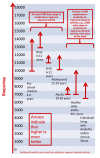How many steps/day are enough? For older adults and special populations
- PMID: 21798044
- PMCID: PMC3169444
- DOI: 10.1186/1479-5868-8-80
How many steps/day are enough? For older adults and special populations
Abstract
Older adults and special populations (living with disability and/or chronic illness that may limit mobility and/or physical endurance) can benefit from practicing a more physically active lifestyle, typically by increasing ambulatory activity. Step counting devices (accelerometers and pedometers) offer an opportunity to monitor daily ambulatory activity; however, an appropriate translation of public health guidelines in terms of steps/day is unknown. Therefore this review was conducted to translate public health recommendations in terms of steps/day. Normative data indicates that 1) healthy older adults average 2,000-9,000 steps/day, and 2) special populations average 1,200-8,800 steps/day. Pedometer-based interventions in older adults and special populations elicit a weighted increase of approximately 775 steps/day (or an effect size of 0.26) and 2,215 steps/day (or an effect size of 0.67), respectively. There is no evidence to inform a moderate intensity cadence (i.e., steps/minute) in older adults at this time. However, using the adult cadence of 100 steps/minute to demark the lower end of an absolutely-defined moderate intensity (i.e., 3 METs), and multiplying this by 30 minutes produces a reasonable heuristic (i.e., guiding) value of 3,000 steps. However, this cadence may be unattainable in some frail/diseased populations. Regardless, to truly translate public health guidelines, these steps should be taken over and above activities performed in the course of daily living, be of at least moderate intensity accumulated in minimally 10 minute bouts, and add up to at least 150 minutes over the week. Considering a daily background of 5,000 steps/day (which may actually be too high for some older adults and/or special populations), a computed translation approximates 8,000 steps on days that include a target of achieving 30 minutes of moderate-to-vigorous physical activity (MVPA), and approximately 7,100 steps/day if averaged over a week. Measured directly and including these background activities, the evidence suggests that 30 minutes of daily MVPA accumulated in addition to habitual daily activities in healthy older adults is equivalent to taking approximately 7,000-10,000 steps/day. Those living with disability and/or chronic illness (that limits mobility and or/physical endurance) display lower levels of background daily activity, and this will affect whole-day estimates of recommended physical activity.
Figures
References
-
- Physical Activity Guidelines Advisory Committee. Physical Activity Guidelines Advisory Committee Report, 2008. Washington, D.C.: U.S. Department of Health and Human Services; 2008.
-
- Global strategy on diet, physical activity and health: Physical activity and older adults. http://www.who.int/dietphysicalactivity/factsheet_olderadults/en/index.html
-
- U.S. Department of Health and Human Services. 2008 Physical Activity Guidelines for Americans: Be Active, Healthy, and Happy! Washington, D.C. 2008.
Publication types
MeSH terms
LinkOut - more resources
Full Text Sources
Other Literature Sources
Medical


